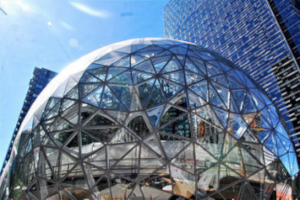Is Amazon Taking Over the B2B World?
- < 4 Reasons Why Online AIA CE Courses Help Product Manufacturers Get Specified
- > How Values Can Affect Building Product Specification
Last week, Amazon announced its investment in Plant Prefab, a Rialto, CA based startup. This isn’t Amazon’s first foray into the construction business. In May 2018, Amazon partnered with Lennar, the nation’s largest homebuilder, to pre-install Alexa in all their new homes. Just days before the Plant Prefab announcement, Amazon released their new line of Alexa-enabled smart home devices. It isn’t a surprise that Amazon seems to want to have Alexa in every home, which is an excellent start to a science fiction story—smart homes take over the world! But really, the more diversified Amazon is, the more money they make, and the more likely they are able to sustain their business model with the ebb and flow of the various markets. But will their expansion into the AEC industry affect projects and specification?
What is Prefab?
I learned some interesting facts about prefabricated homes, while researching this new partnership:
- Prefab homes, also called modular homes, are built indoors in a factory-like setting. The finished products are then protected and transported to their permanent location, to be assembled on-site by the builder.
- Prefab is not the same as manufactured. While both are built similarly, one main difference is that manufactured homes are not built on permanent foundations and can be relocated.
- Prefab homeowners usually must own the land that the prefab home will be built on.
- Prefab homes can be completed much quicker than built-on-site homes, which often face weather delays, on-site team challenges, or supply issues. The difference in time can be a couple weeks for a prefab home as opposed to a few months for a built-on-site home.
- Prefab homes can (sometimes) be less expensive than site-built houses.
- Prefab homes do not depreciate, they appraise the same as traditional construction, and they are subject to the same financing, taxes, and insurance premiums.
- Prefab homes vary in design options and can be customized.
- Prefab homes are considered a good option for green building and are much more energy efficient.
It appears that the differences between built on-site homes and prefab homes are few. So, with Amazon’s investment in a prefab startup, does this mean they will expand into the build and design industry as more than an investor, and will any of this affect the AEC industry and specification the way brick and mortar bookstores were when Amazon began in the book business?
A Different Way to Sell B2B
An article found on Curbed.com about this new Amazon venture states, “While Amazon has plenty of construction needs, between current expansion in Seattle, future construction of its HQ2, as well as continued expansion in warehouse and logistics space, one of its primary focuses has been getting Alexa, its smart assistant, in more homes…” According to this, then, Amazon’s main goal is to find a way to get Alexa in homes from the beginning and investing in a prefab startup is one way to gain leverage. Even though prefab tiny homes have been sold on Amazon since 2017, they weren’t sold for any more gain than what Amazon typically gets.
But investing in a prefab startup is different than selling someone else’s product. While minimal construction supplies are available for sale on Amazon, it appears that they are marketed more toward the individual consumer, meaning they aren’t a threat to specification opportunities for product manufacturers. Except, they may be changing the landscape of specification.
An article from last year on DigitalCommerce360.com by Brian Beck, senior vice president of e-commerce and omnichannel strategy at Guidance, an e-commerce design and development agency, addresses this topic. Beck says, “In my opinion, it is only a matter of time before Amazon disrupts the B2B marketplace in similar fashion. The brutal reality is that Amazon has the expertise, deep pockets, data, and incredible execution capabilities that will change how and where business buyers are transacting. Make no mistake–this is already happening. Amazon is investing heavily in enabling business buyers to purchase online using the same tools and user experiences these same buyers have become accustomed to as consumers in shopping for their personal purchases on Amazon.com. The company calls this Amazon Business, and they are executing right now to digitally support traditional B2B workflows and customers’ purchasing expectations.”
If this is true, how will it affect specification for product manufacturers? I don’t know the answer to that, but I’ve been reading a lot lately about the many different ways product specification, manufacturing, and the AEC industry are changing—from 3D printing to focusing on resiliency to...well, to homes being sold on Amazon. It is safe to say if you are a product manufacturer, it would benefit you to investigate how Amazon’s new ventures can help or hurt your business and specification opportunities.
In the Meantime…
Product specification opportunities can always be maximized by knowing the ins and outs of the industry you’re selling to. If you or your team aren’t yet a LEED Green Associate, you can begin preparing for that with our free LEED Prep Exam and increase specification opportunities on LEED projects. And, if you’re interested in information on how we help product manufacturers with specification, check out the info here.
Have you used Amazon for any B2B transactions? Do you think this will change product manufacturing specifications at all?
For more information or to discuss the topic of this blog, please contact Brad Blank





